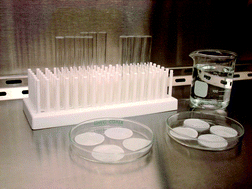Air sampling for (1 → 3)-β-D-glucan may be a good method for assessing inhalation exposure to airborne fungi. Pre-sampling contamination of filter media used for sampling (1 → 3)-β-D-glucan may lead to substantial exposure measurement errors. Using the Limulus amebocyte lysate assay, we tested for pre-sampling levels of (1 → 3)-β-D-glucan on three types of filters—mixed cellulose ester (MCE)[1 brand], glass fiber (GF)[1 brand], and polycarbonate (PC)[5 brands]. Levels of (1 → 3)-β-D-glucan on MCE filters exceeded 4586.1 pg per filter. Levels on GF filters averaged 135.3 (±28.9) pg per filter (range = 94.8–160.4 pg per filter) and levels on PC filters averaged 152.4 (±236.1) pg per filter (range = non-detectable–1760.7 pg per filter). Efforts to clean MCE and GF filters were unfeasible or unsuccessful. Sonicating PC filters for two hours in ethanol, followed by a wash in pyrogen-free water, effectively eliminated measured levels of (1 → 3)-β-D-glucan on four brands of PC filters, as compared to untreated PC filters. This pretreatment process did not appear to physically damage the PC filters. Air sampling results highlighted the potentially problematic contamination of untreated PC filters. Ensuring that sampling media are free of (1 → 3)-β-D-glucan before sampling is crucial to accurately measure levels of (1 → 3)-β-D-glucan exposure, especially in environments where levels of (1 → 3)-β-D-glucan are low.

